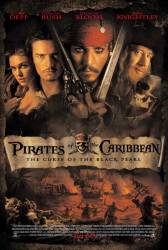Continuity mistake: Between the two shots of Pintel and Raggeti's cannon, the position of the cutlery around the porthole changes entirely.
Revealing mistake: The cannonballs are solid balls and not self-exploding cannonballs (as can be seen from the handling on board of the Pearl). As such they cannot explode when they hit a target. Even if they were self-exploding cannonballs, they would simply explode and not cause yellowish fire flares around them. The type of fire that is seen after impact comes from a liquid, not anything made of powder (particularly noticeable with the cannonball that hits the prison that lets the prisoners escape).
Factual error: The British warships in the film - and in the whole series, for that matter - are painted in a livery far too modern for the period in which the film is evidently set. The "Golden Age of Piracy," during which the movie takes place, occurred in the early 1700s, but the Royal Navy did not begin using the yellow-and-black "Nelson Chequer" on its vessels until the Battle of Trafalgar in 1805. Even if the film were actually set in the later period, there would still be an inaccuracy in that the Marines' headwear would be incorrect - they transitioned from the tricorne to a round hat in 1802.
Suggested correction: This is not completely correct; it did not originate with Nelson. It only became immensely popular and somewhat uniform in its use after his victory at Trafalgar. The Royal Navy mandated the use of a uniform yellow and black paint job as early as 1715, but that order was routinely ignored. Still, it would not have been impossible or improbable for the two ships in the film to be black and yellow.
Revealing mistake: When Captain Jack and Will are walking in the upside down boat, from the outside it looks like it's made of fibre glass rather than wood.
Continuity mistake: During the Black Pearl's ambush on Port Royal, they destroy a wall to the prison. Pirates in one cell manage to escape from a hole in the wall destroyed by one of the boat's cannons and Jack is stuck in his cell because the hole isn't big enough for him to fit through. As this happens, we can actually see the small hole when one of the pirates say "My sympathies. You've no manner of luck at all" as the other pirates escape the cell. Yet in the next shot as Jack is watching the other pirates escape, the small hole in Jack's cell is now smaller than it was in the previous shot.
Other mistake: When the Interceptor reaches the "boat graveyard" just off the dreaded island, it hits a pole or other assembly from another boat underneath them. It then "falls", literally plummets, downward and hits the ground with a thud. But wood doesn't "fall" downward through water, in fact, most wood swims. Even with other metal or other objects attached to it, this whole piece/assembly would have to be solid lead to "plummet" at that speed through water. No matter what the material is, it cannot go down that fast through water.
Factual error: The scriptwriters revealed that they placed the story in a thirty-year environment set loosely between 1720 and 1750. Port Royal was destroyed by an earthquake on 7 June 1692, which had an accompanying tsunami. An initial attempt at rebuilding was again destroyed in 1703 by fire. Subsequent rebuilding was hampered by several hurricanes in the first half of the 18th century. I don't remember if the movie was set in a big, undestroyed Port Royal. However there was also set a huge fortress in Port Royal, which is definitely a factual error.
Suggested correction: This is also not the real world. It's set in an alternate reality which doesn't have to exactly match our reality.
Although the film series falls into the fantasy genre, it is set in a real period and place in history. Fictional events taking place in a historical setting is not the same as an "alternate reality." The anachronistic use of a real city as an important locale in the story is not artistic license, it is a historical error.
Continuity mistake: After young Elizabeth tells young Will "I'm watching over you", there's a strand of hair over his ear, which appears and disappears randomly depending on the shot.
Continuity mistake: Young Will lays unconscious by the edge of a blanket. When the angle changes there's much more blanket behind.
Visible crew/equipment: When Elizabeth is first taken aboard the Pearl you can see the yellow coloured contact lenses that Captain Barbosa is wearing.
Other mistake: When Jack looks at the Pearl from his prison window, he is at least 10 boat heights above the ship. As we see throughout the movie when we look at the cannons of the Pearl and how they stand on the floor and shoot through the openings of the ship, there is no way that they could be rotated upwards to shoot as high as would be necessary to hit the prison cell.
Continuity mistake: Barbossa's scar changes appearance several times during the movie. At times it's almost completely gone, and sometimes it's even quite "thick".





